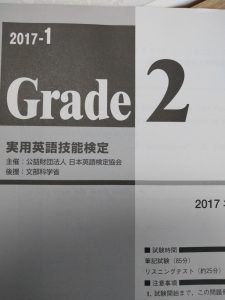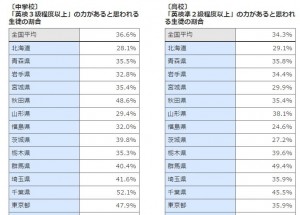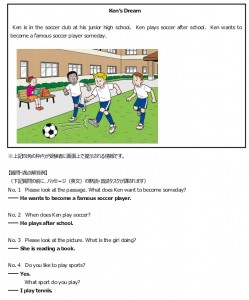Changes to the STEP Eiken Tests (June 2017)
There have been a few…
The STEP Eiken Test is probably the best-known and most widely-recognized test of English for Japanese schoolchildren. It is closely tied to the school curriculum and the organization that produces it is trying to get more involved with university entrance tests once they are mandated to be 4-skills (from 2020).
Recently there have been quite a few changes to the STEP Eiken tests, most of which took me by surprise, so this post is to give other teachers a heads-up as to what has changed and what the latest version of the test looks like.
It seems as though the Eiken Foundation is trying to make the tests more rigorous in line with the new Course of Study and objectives for English education in Japan (particularly with regards to the upcoming changes to the university entrance tests).
I’ll describe each level in detail below, but the general changes are:
- the test seems to have gotten harder overall (the vocabulary and reading sections seem more difficult to me)
- there are new written sections in levels 3 and pre-2 (2, pre-1, and 1 already had a written section)
- there are new, optional, online “speaking” tests for levels 5 and 4
- the interview tests for levels 2, pre-2, and 3 are more rigorous: you now have to pass each section in order to pass the test. Merely getting a passing score is no longer enough to pass (we had a student fail with 20 points last time)
- interview examiners can no longer keep the interview cards and manuals, which is going to make practicing more difficult in the future 😉
Grade 5
The grade 5 test is 25 minutes for the paper and 22 for the listening. It consists of:
15 vocabulary questions (choose the word that goes in the blank)
5 conversation questions (choose the phrase that goes in the blank)
5 ‘rearrange the sentence’ questions (put the words in order)
10 listening questions with reference pictures
5 listening questions where you choose a written answer
10 listening questions where you answer about a picture
Overall I think the test seemed similar to previous years. No huge changes.
Grade 4
The grade 4 test is 35 minutes for the paper test, and 28 for the listening. It consists of:
15 vocabulary questions (choose the word that goes in the blank)
5 conversation questions (choose the phrase that goes in the blank)
5 ‘rearrange the sentence’ questions (put the words in order)
10 questions based on reading passages (one easy, one medium, and one difficult)
10 listening questions with reference pictures
20 listening questions where you choose a written answer
The reading section seems to have gotten harder in this test. The final text was really hard.
Grade 3
The grade 3 test is 50 minutes for the paper test, and 25 for the listening. It consists of:
15 vocabulary questions (choose the word that goes in the blank)
5 conversation questions (choose the phrase that goes in the blank)
10 questions based on reading passages (one easy, one medium, and one difficult)
1 writing exercise where students have to write 25-35 words and answer a question giving two reasons. The question this time was: “Where do you want to go during your summer vacation?”. They seem to be using old questions from the level 3 speaking test for this section.
10 listening questions with reference pictures
20 listening questions where you choose a written answer
The reading section seems to have gotten harder in this test. The final text made me think. The new writing section is going to trip up students who haven’t done much writing or practiced for this section of the test.
Grade pre-2
The grade pre-2 test is 75 minutes for the paper test, and 25 for the listening. It consists of:
20 vocabulary questions (choose the word that goes in the blank)
5 conversation questions (choose the phrase that goes in the blank)
5 vocabulary and phrase questions (choose the words that go in the blank in longer passages)
7 questions based on reading passages (one easy, one medium, and one difficult)
1 writing question where they examinees have to write 50-60 words and answer a question giving two reasons. This time the question was: “Do you think it is better for people to eat in restaurants or at home?”.
10 listening questions with no visual reference
20 listening questions where you choose a written answer
Overall this test felt slightly harder. Again, the writing question is similar to past interview questions for grade pre-2. The pre-2 test feels too long now. I think they have given too much extra time for the writing section.
Grade 2
The grade 2 test is 85 minutes for the paper test, and 25 for the listening. It consists of:
20 vocabulary questions (choose the word or phrase that goes in the blank)
6 vocabulary and phrase questions (choose the words that go in the blank in longer passages)
12 questions based on reading passages (one easy, one medium, and one difficult)
1 writing question where they examinees have to write 80-100 words and answer a question giving two reasons. This time the question was: “Today, more and more young people are starting their own companies. Do you think this is a good idea?”
30 listening questions where you choose a written answer
Overall this test felt slightly harder. Again, the writing question is similar to past interview questions for grade 2. This test also feels a bit too long.
I haven’t seen the new grade pre-1 or 1 tests yet, but I presume they haven’t changed as much. You can see past papers and a lot more information at the STEP Eiken website.
Anything to add? How are you finding the new tests?
Japanese High School Students’ English
Unsurprisingly similar to junior high school students’ English
Following on from the report on Japanese junior high school student English proficiency, I saw this article today about high school students (also this better article with the percentages for each prefecture in Japanese). Miyagi sadly is below the national average for both junior and senior high school.
I don’t think the results are very surprising.
I do wish they would use better tests to set targets, as in my experience it is possible to pass Eiken with relatively poor English skills if you are lucky or prepare for the test format. I would prefer to see a test with separate scores for skills rather than the catch-all pass/fail STEP Eiken.
Also the root of the problem can be seen here: poor English teacher language proficiency. It is incredible, given how much effort and resources Japan puts into English education, that people with insufficient practical language ability are employed to teach it. It should be a huge priority to encourage and help English teachers in junior and senior high school improve their language skills, and to make practical language proficiency a firm requirement when hiring new English teachers.
And of course, everyone should be doing extensive reading and listening 😉
Young Children and STEP Eiken
Unprofessional and Irresponsible
I’m going to be blunt here. I believe forcing young children to take the STEP Eiken test has a high chance of being pointless, counter-productive, and even irresponsible.
Yesterday I got involved in a debate on Facebook after someone reposted an update from the owner of an English immersion kindergarten announcing one of their six-year-olds had passed the pre-2 Grade of the STEP Eiken test. They also mentioned this same kindergarten had been in the news a while back for having a six year old pass the pre-1 Grade test.
Now, I don’t have a problem with the STEP Eiken test. My wife’s school is an Eiken test centre and I have been involved with various aspects of the test for the last decade. I think it does a perfectly good job of what it was designed to do: certify that (mainly) junior and senior high school students have acquired the grammar and vocabulary they are taught in school. The tests are designed to match up to school years as follows:
Grade 5 Eiken -> finished JHS 1st grade English
Grade 4 Eiken -> finished JHS 2nd grade English
Grade 3 Eiken -> finished JHS 3rd grade English
Grade pre-2 -> mid-SHS English
Grade 2 -> finished SHS English
Grade pre-1 -> university equivalent English
Grade 1 -> high proficiency in English for professional use
The tests seem to be most useful when applying to high school or university, or when working as an English teacher or public servant. It’s been around for a long time, and is probably the best-known English qualification in Japan.
Which brings us to young children.
Many parents, not knowing better, have an impression of Eiken as a general English test. In their eyes, passing Eiken means that someone has a certain English ability. They then decide that it would be good for their children to pass Eiken earlier than usual.
Now, for some students, taking the STEP Eiken test slightly early is not a bad thing. For the right student who is ready, it can be a confidence boost, a way to get used to taking tests, and a way to show parents that students have acquired some English skills.
The problem arises when parents take it too far and push their children into taking it too soon.
Pointless
There is no point in taking the Eiken test very early. It is mainly used for recommended entry into high schools (passing the Grade 3 or pre-2 test displays a mastery of junior high school English) or universities (Grade 2 shows a mastery of high school English, while pre-1 or 1 show advanced English proficiency).
Passing the test at a very early age confers no advantage, and now that the tests have an expiry date on them just means that students will have to take them again nearer the time they will need to use them.
The only reason I can think of to take tests early is so that parents or schools can brag about it.
Counter-productive
It can be stressful and uncomfortable for children to prepare for tests they are not ready for developmentally. Pencil use, writing their name and address, and filling in mark sheets correctly are all difficult for younger children. Beyond Eiken pre-2, the content of the tests takes an academic turn. Questions refer to social and environmental issues. Written and spoken tests expect a certain format for answers. Forcing children to conform to this is wasting time that could be used to learn English more appropriately, through stories, play, and interaction with teachers and peers.
I had a young boy come to an Eiken speaking test once and ask me in beautifully accented English to fill in his test card for him, because he couldn’t write his name and didn’t know his phone number. He failed the test as he didn’t seem to understand that it was a test and couldn’t stay on point. His English was beautiful but he wasn’t ready to take a highly structured test.
Another time I was ‘helping’ a ten-year old boy who had spent a long time in the US with the Eiken 2. As we worked through past papers, it became clear that he didn’t know the concepts, let alone the vocabulary, for a lot of the questions. It was heartbreaking, but at that time I didn’t have the experience or the confidence to stand up to his parents.
Irresponsible
I believe schools and teachers have a duty to educate parents about the nature and purpose of tests so that they can make appropriate decisions regarding their children. Failing to do so, in my eyes, makes a teacher or school unprofessional, irresponsible, and even negligent.
There are a number of English tests developed specifically for young children, such as the Cambridge YLE, junior UN Eiken, or junior STEP Eiken tests. Students can also show their skills through performance, in-class assessment, or creating portfolios of their work. With so many appropriate alternatives, please think carefully before putting the wishes of parents or your own commercial interests ahead of what is best for each child.
What do you think? Am I being too harsh? Are there any good reasons for having very young children take the STEP Eiken?
STEP Eiken 4-kyu, 5-kyu Speaking Test from June 2016
Where are they going to find the interview testers???
I just read this press release/informational pamphlet on the STEP Eiken website (thanks for the tip, Mary!)
From June this year (ie the 2016-1 session of the STEP Eiken test) 5-kyu and 4-kyu will have a speaking test.
At first I was extremely surprised and wondered where they were going to find the interviewers to cope with these thousands of additional test, but then I read the content.
The new speaking tests will be online, can be done at any time, and will not affect whether students pass or fail the main STEP Eiken test. Instead students will receive an additional pass/fail certificate for the speaking test. I believe from the write-up that students will record their spoken answers and submit them via a website. Presumably Eiken will mark them using software, so it will be important to stick to the prescribed answer formats.
I’m guessing they will get those two annoying voice actors to do the audio (who is that woman, by the way? Sendai City got her to do the new subway line safety announcements, so now I have to listen to her every day rather than just for a couple of months a year…).
This is the content of the 4-kyu test.
And here is the 5-kyu.
As you can see (click on the graphics to make them bigger or just look at the original eiken version), they are both kind of watered down versions of the 3-kyu speaking test. Don’t know how they are going to guarantee the reliability of the test if students can take it at home with their parents or at school with their teachers, but I guess the stakes aren’t very high here and that’s why they decided to have it run parallel to (instead of be a part of) the paper test.
It’s probably a positive development and hopefully will put more emphasis on speaking skills for junior high school students. I don’t like that students have to read to answer the questions. It would be better to have them exclusively based on pictures and audio like the Cambridge YLE tests, but such is eiken 🙂
What do you think about the new speaking tests?




